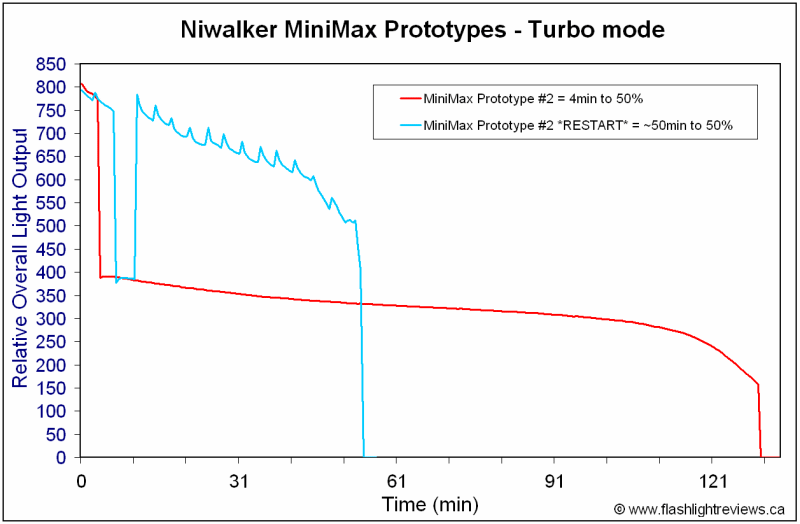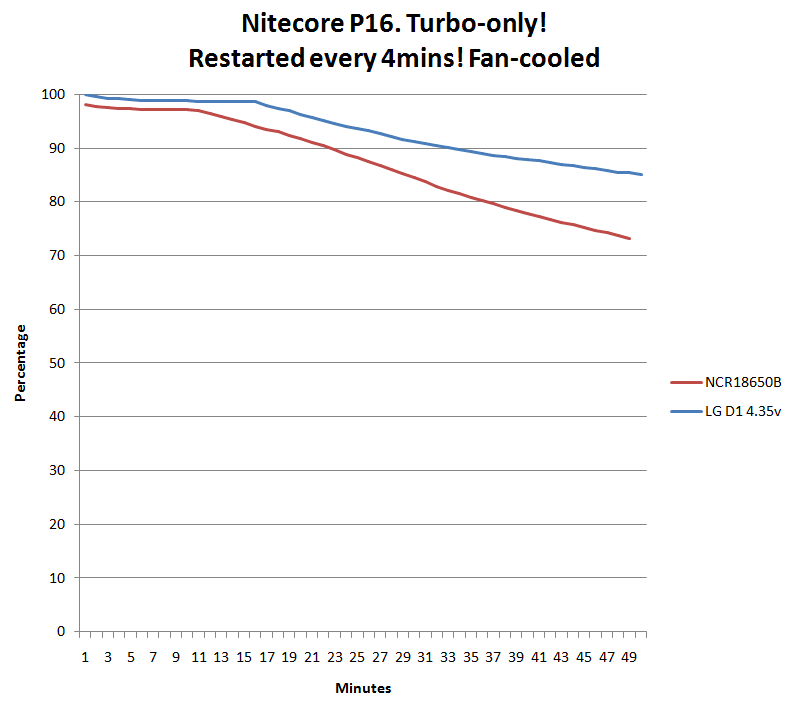It took me a while to see the significance of the graphs produced by Selfbuilt, but now I have some questions about them, and did not find answers on his website. I'm looking at the graphs, and see different patterns. For a given LED light, some start with a peak lumen output that falls quickly after a few minutes. Others have a flatter declining slope. I cannot tell if the run time graph is only applicable to a continuous use of the light until it runs dry, or whether it also reflects the use of the light over a series of uses with the same batteries. A roller coaster metaphor comes to mind to explain two ways the graphs may apply to normal use of the flashlights.
Interpretation 1: You turn on the light when it is fully charged (for example, X=0 on the graph, Y=10), you leave it on high/max, and a few minutes later, it begins to drop in output level (X=3, Y=7). You turn off the light (X=3, Y=7), but when it you turn it back on, it picks roughly where you left off on the slope function (X=3, Y=7), and the drain continues to follow the run-time graph pattern. It's like you are riding a roller coaster from the top of the hill, and each time you turn off the light, the coaster stops on the tracks and you get off. When you turn on the light again, you get back in the roller coaster car at the same place you left off, and continue to ride down the remainder of the slope, until you want to get off, then the car stops again.
Interpretation 2: You turn on the light and it starts at some peak output level for fully-charged batteries (X=0, Y=10). Each time you turn back on the light, you go back to X=0 on the graph, although you may start at a lower peak starting level (Y<10) because the battery has lost some charge since your last use. On this roller coaster, you ride it down the slope until you decide to get off. When you get back on, the roller coaster has moved back to top of the hill, and you ride it back down the hill again. (The metaphor probably breaks down because the batteries lose charge, and so even though you are starting from the top of the hill when you turn on the light each time, the hill is not as high as it during the last ride, even though the downward slope of the hill is the same).
Are either of these an accurate way of understanding the run time graphs?
Interpretation 1: You turn on the light when it is fully charged (for example, X=0 on the graph, Y=10), you leave it on high/max, and a few minutes later, it begins to drop in output level (X=3, Y=7). You turn off the light (X=3, Y=7), but when it you turn it back on, it picks roughly where you left off on the slope function (X=3, Y=7), and the drain continues to follow the run-time graph pattern. It's like you are riding a roller coaster from the top of the hill, and each time you turn off the light, the coaster stops on the tracks and you get off. When you turn on the light again, you get back in the roller coaster car at the same place you left off, and continue to ride down the remainder of the slope, until you want to get off, then the car stops again.
Interpretation 2: You turn on the light and it starts at some peak output level for fully-charged batteries (X=0, Y=10). Each time you turn back on the light, you go back to X=0 on the graph, although you may start at a lower peak starting level (Y<10) because the battery has lost some charge since your last use. On this roller coaster, you ride it down the slope until you decide to get off. When you get back on, the roller coaster has moved back to top of the hill, and you ride it back down the hill again. (The metaphor probably breaks down because the batteries lose charge, and so even though you are starting from the top of the hill when you turn on the light each time, the hill is not as high as it during the last ride, even though the downward slope of the hill is the same).
Are either of these an accurate way of understanding the run time graphs?
Last edited:




